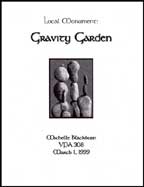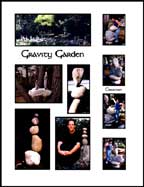|
California State University at Monterey Bay Survey of Public Monuments Gravity Garden BY MICHELLE BLACKBURN March 1, 1999 Gravity Garden is located on Highway One in the Carmel Highlands. It is a fascinating piece of public art in that it is made entirely out of river rock. Some weigh half a pound; some weigh over several thousand pounds. What is unusual about these rocks is the way they are arranged in the garden. They are formed into "rockstacks" or perfectly balanced vertical towers of rocks. To date, over forty tons of rocks make up this monument. Each rock was hauled from the Carmel River to the garden's site. It was started in 1996 and is a work in progress. This is a unique piece of public art. It is not a permanent structure in the traditional sense. The rocks are not attached to one another nor are they cemented to the ground. Anyone who felt the urge could topple a rock stack with a simple push. This doesn't happen, though. Maybe it's the sense of awe felt being among these seemingly impossible towers. At least to me, it would be sacrilege to lay even a finger on this creation. It seems the only adversary of Gravity Garden is Mother Nature's elements. The artist who created the Gravity Garden is a man named Jim Needham. He has completed eight commissions in Monterey County and is currently working on a large rock stack for Carmel Middle School. He is a local artist who lived in Carmel Valley for fifteen years, but now travels between his various rockstacking sites. Needham graduated from the San Francisco Art Institute in the seventies and is a highly respected photographer. His photographs have been displayed throughout this country as well as Europe and Japan. Needham started stacking rocks just about four years ago. He collected rocks from the Carmel River after the 1995 floods without really knowing why. He had an inspiration and began stacking them and has been doing so ever since. He started this art form in Carmel Valley and had such a positive response from the community he decided he needed a more visible location to display his work. He chose the prominent roadside property of a friend in the Carmel Highlands. Needham has constructed Gravity Garden to be strolled through, forming paths so the public may walk among the many stacks. Each side of a path offers a different view of the rocks. On one side you are looking down the stacks. On the other, they are looking you in the eye and sometimes even looking down on you. Needham told me that the most prevalent emotion felt in his garden is peace. People tell him they feel a sense of balance and a connection to the earth. And the site has many, many visitors. During the portion of a day I was with him many people pulled over for a look at his unusual garden. I was fortunate not only to catch Needham in town, but also to watch him create one of his rock stacks. His process at first appears to be simple: Pick two rocks, stack them, stack another on top of them and so on. Watching him work, however, I gained a sense of the logistics involved in stacking rock. The first two placements are relatively easy. They are low to the ground and not too difficult to maneuver. But what about the third, forth or fifth? Many stacks are several yards high. Rocks are heavy! Needham uses no man-made machinery. He employs only levers and sheer strength to move the rocks up on to the stack. After the third or fourth rock goes up, the stack begins shifting and teetering in what Needham refers to as "the dance." Indeed it does seem like a dance. He had both arms around the rocks and was moving with them trying to find the exact meeting point of the two rocks that would result in a perfect balance. When he sensed he had achieved balance, he let go. And behold, the rocks appeared to be held up by magic. This process takes time. How long does Needham work in his garden? Often until physical exhaustion sets in. So what is Needham trying to say through Gravity Garden? His statement has to do with education, specifically children and our school systems. He told me his garden "is a celebration of the uniqueness of each thing." Needham believes our schools stifle this uniqueness in an effort to make all children uniformly educated. He uses his rock stacks as an example of what uniqueness can offer. He proposes that although a square brick may seem inherently steadier than a round rock, if a brick is stacked on top of another, on top of another, and so on, the stack will topple because it has no balance. Round rock on the other hand, can be stacked much higher because of balance and gravity, as Needham has proven. I think Needham's rationale is quite in line with this university's view of education. Each person is unique and should be allowed to exercise that uniqueness in the learning process. It seems the "well rounded" person has much in common with this monument. The garden is in an ever-changing state. Whenever Needham is in town he devotes time to creating new rock stacks and re-stacking any that may have fallen. And he seems to know the location of each rock. As we walked through the garden he stopped, studied a stack and knew two had fallen. He hunted around until he found the errant stones and placed them back where they belonged. I chose this sight in part because it doesn't commemorate religious conquering, commercial industry, or military heroics. Gravity Garden was created by a local artist with local materials for the community. I also chose this monument because I was taken with the amazing amount of trust Needham puts in humanity. There is no fence around the garden, no admission fee. I asked him if he ever worried about rotten kids knocking down his rock stacks. He simply replied, "There are no rotten kids." Located 3 miles south of Carmel in the Carmel Highlands on the corner of Fern Canyon Rd. and Highway One, approximately one mile south of Point Lobos State Reserve. Open to the public seven days a week. |
||||
 |
||||
 |
||||
 |
||||
|
|
||||